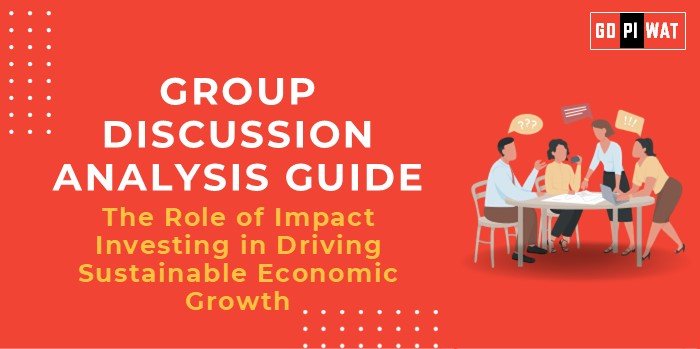📋 Group Discussion (GD) Analysis Guide: The Role of Impact Investing in Driving Sustainable Economic Growth
🌍 Introduction to the Topic
- 💡 Opening Context: Impact investing, which combines financial returns with measurable social and environmental benefits, is emerging as a powerful tool to drive sustainable development globally. With the market valued at over $1 trillion, its role in addressing global challenges such as climate change, poverty, and inequality is increasingly evident.
- 📜 Topic Background: Originating in the early 2000s, impact investing has gained momentum due to the growing demand for sustainable economic models. It aligns with the UN’s Sustainable Development Goals (SDGs) by channeling capital toward inclusive and green initiatives.
📊 Quick Facts and Key Statistics
- 🌍 Global Market Size: $1.164 trillion as of 2023 (GIIN).
- 📈 Investor Returns: 91% of impact investments meet or exceed financial expectations (GIIN, 2022).
- 🇮🇳 India’s Market Size: $10 billion annually, focusing on clean energy, microfinance, and healthcare.
- 🌎 SDG Alignment: Impact investing addresses 15 of 17 UN SDGs.
👥 Stakeholders and Their Roles
- 🏛️ Governments: Provide incentives and regulatory support for sustainable investments.
- 💼 Private Investors: Allocate funds toward projects with social and environmental impact.
- 🚀 Social Enterprises: Implement projects that align profitability with sustainability.
- 🌐 Multilateral Institutions: Promote impact investing globally through partnerships and funding.
🏆 Achievements and ⚠️ Challenges
Achievements:
- ✅ Financial Inclusion: Microfinance initiatives, supported by impact investments, have empowered over 300 million individuals globally.
- 🌞 Renewable Energy Growth: In India, $7 billion in impact investments has driven renewable energy projects since 2010.
- 💊 Healthcare Access: Initiatives like Healthquad fund affordable healthcare for underserved populations.
Challenges:
- 📏 Measurement Issues: Difficulty in quantifying social and environmental impacts.
- ⚠️ High Risk Perception: Hesitation among traditional investors due to perceived risks and lower liquidity.
- 📉 Lack of Awareness: Limited understanding of impact investing among retail investors.
Global Comparisons:
- 🇳🇱 Success: The Netherlands leads with green bond investments and policy integration.
- 🌍 Challenges: In sub-Saharan Africa, limited infrastructure hampers scalable impact investment projects.
Case Study:
- 💡 Selco India: Impact investments have enabled the firm to provide affordable solar solutions to over 500,000 rural households, driving sustainable energy access.
📋 Structured Arguments for Discussion
- 📈 Supporting Stance: “Impact investing aligns profitability with purpose, fostering sustainable economic growth and addressing global challenges.”
- 📉 Opposing Stance: “The scalability of impact investing is constrained by risk perception, measurement challenges, and limited awareness.”
- ⚖️ Balanced Perspective: “While impact investing holds potential for sustainable growth, strategic policy support and innovation are essential for overcoming barriers.”
💡 Effective Discussion Approaches
- 📊 Opening Approaches:
- 📈 “With a $1.1 trillion global market, impact investing demonstrates how capital markets can drive sustainable change.”
- 🔄 “While impact investing promises sustainability, its adoption faces challenges like scalability and risk management.”
- 🔍 Counter-Argument Handling:
- 💬 Acknowledge challenges in measuring impact but highlight innovations like blockchain for transparent reporting systems.
🔍 Strategic Analysis of Strengths and Weaknesses
- ✨ Strengths: Positive social impact, alignment with SDGs, financial returns.
- ⚠️ Weaknesses: High-risk perception, limited liquidity, complex impact measurement.
- 🚀 Opportunities: Policy incentives, tech-driven transparency, growing investor interest.
- ⛔ Threats: Regulatory uncertainty, global economic instability, limited infrastructure in developing regions.
📘 Connecting with B-School Applications
- 📚 Real-World Applications: Developing impact-focused financial models in sectors like microfinance, clean energy, or education.
- 💬 Sample Interview Questions:
- 🔎 “How can impact investing contribute to achieving the SDGs?”
- 🔎 “What role do technology and innovation play in scaling impact investing?”
- ✨ Insights for B-School Students: Explore the intersection of finance, sustainability, and innovation to design scalable, impact-driven solutions.


